Economics Assignment: Analyzing Market Issues - Parks, Power & Pharma
VerifiedAdded on 2023/06/12
|9
|1779
|79
Homework Assignment
AI Summary
This economics assignment delves into several microeconomic issues. It begins by comparing the effects of price increases versus quotas on consumer surplus and welfare in national parks, using graphical analysis to determine the superior policy. The assignment then discusses the high costs associated with permanently closing an electricity plant, contrasting this with short-run shutdowns. Furthermore, it analyzes the circumstances under which a drug company might charge more for its drug after its patent expires and evaluates the argument that reducing patent length could lead to even higher prices during the patent period. Finally, the assignment examines the reasons behind price discrimination in the airline industry, specifically focusing on how different prices are charged for the same trip depending on the direction of travel, relating this practice to profit maximization and customer segmentation.
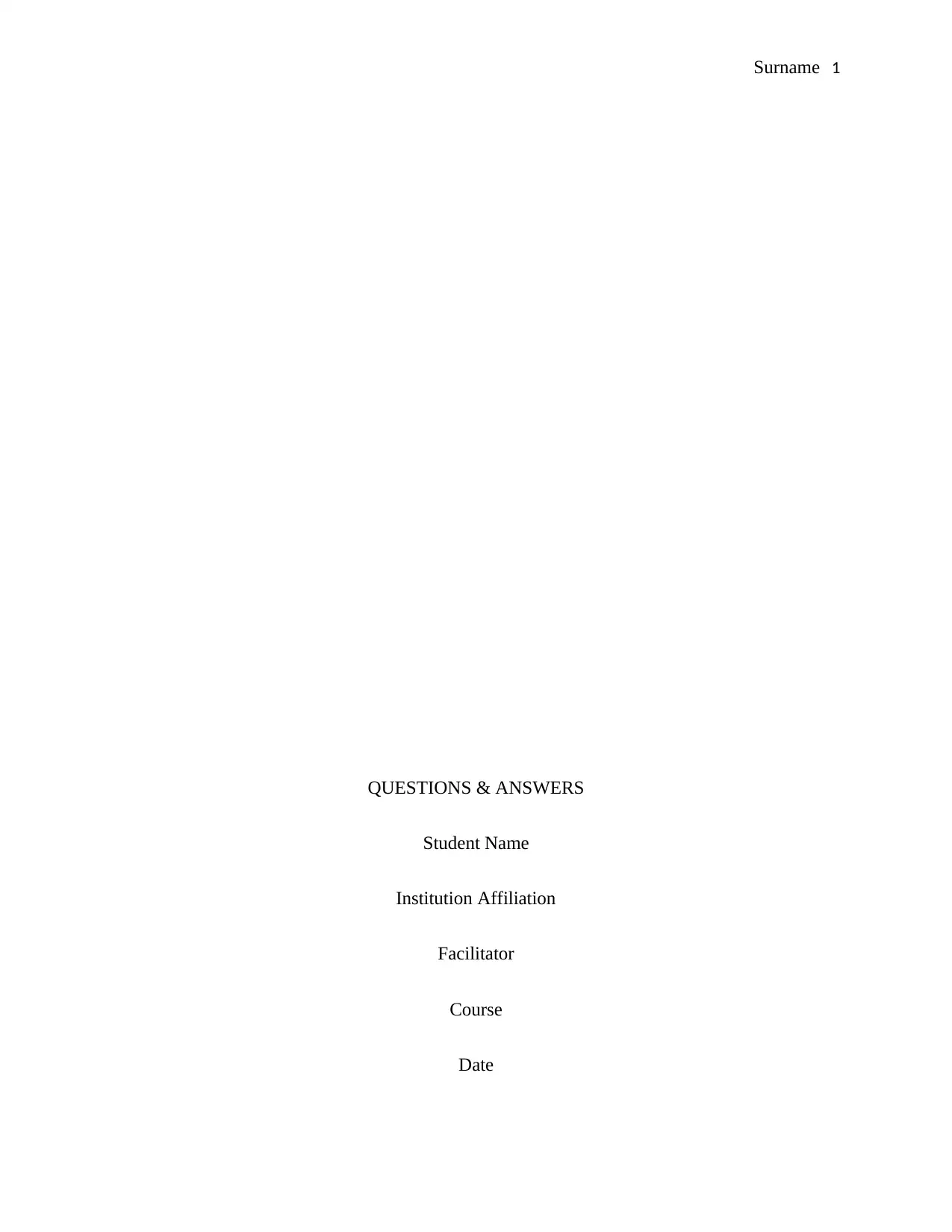
Surname 1
QUESTIONS & ANSWERS
Student Name
Institution Affiliation
Facilitator
Course
Date
QUESTIONS & ANSWERS
Student Name
Institution Affiliation
Facilitator
Course
Date
Paraphrase This Document
Need a fresh take? Get an instant paraphrase of this document with our AI Paraphraser
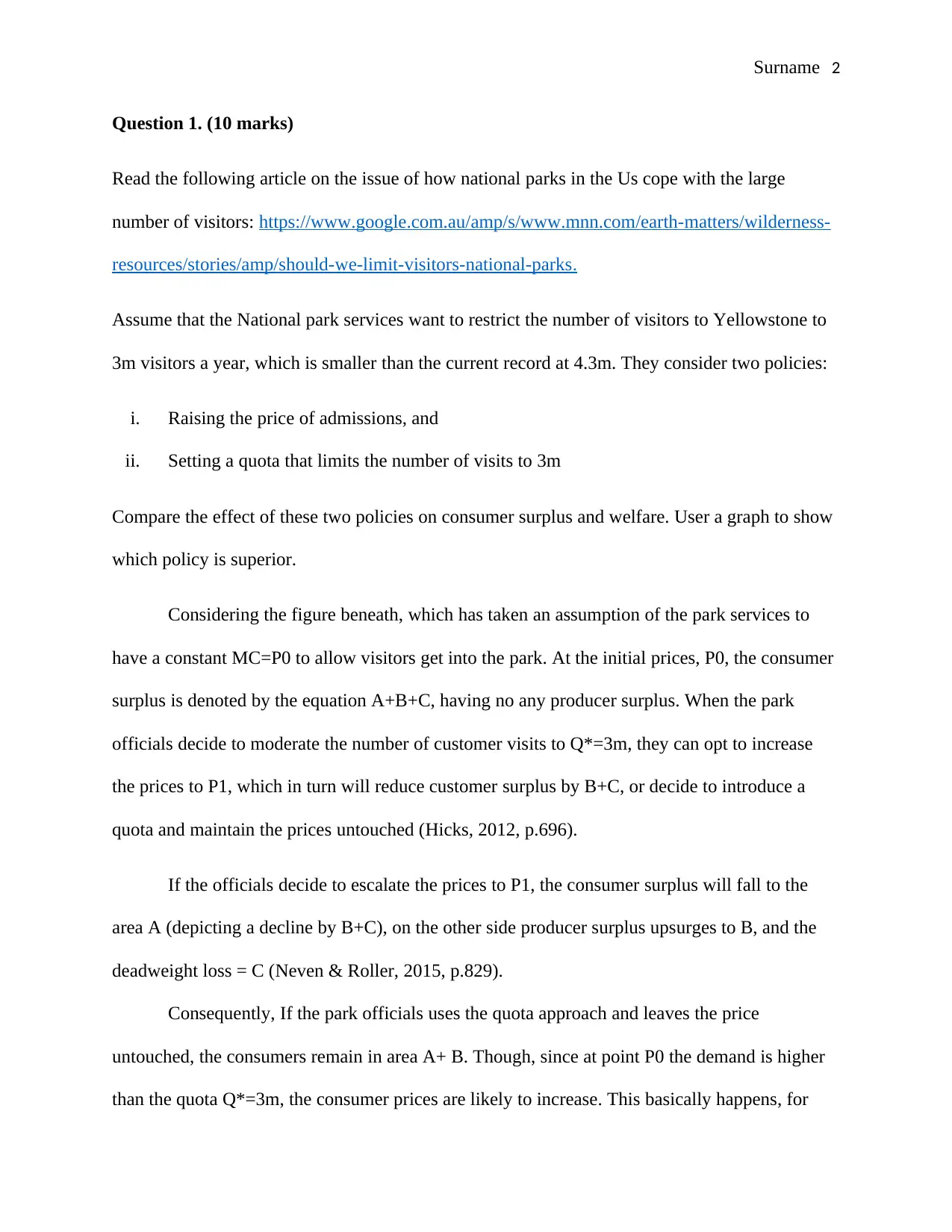
Surname 2
Question 1. (10 marks)
Read the following article on the issue of how national parks in the Us cope with the large
number of visitors: https://www.google.com.au/amp/s/www.mnn.com/earth-matters/wilderness-
resources/stories/amp/should-we-limit-visitors-national-parks.
Assume that the National park services want to restrict the number of visitors to Yellowstone to
3m visitors a year, which is smaller than the current record at 4.3m. They consider two policies:
i. Raising the price of admissions, and
ii. Setting a quota that limits the number of visits to 3m
Compare the effect of these two policies on consumer surplus and welfare. User a graph to show
which policy is superior.
Considering the figure beneath, which has taken an assumption of the park services to
have a constant MC=P0 to allow visitors get into the park. At the initial prices, P0, the consumer
surplus is denoted by the equation A+B+C, having no any producer surplus. When the park
officials decide to moderate the number of customer visits to Q*=3m, they can opt to increase
the prices to P1, which in turn will reduce customer surplus by B+C, or decide to introduce a
quota and maintain the prices untouched (Hicks, 2012, p.696).
If the officials decide to escalate the prices to P1, the consumer surplus will fall to the
area A (depicting a decline by B+C), on the other side producer surplus upsurges to B, and the
deadweight loss = C (Neven & Roller, 2015, p.829).
Consequently, If the park officials uses the quota approach and leaves the price
untouched, the consumers remain in area A+ B. Though, since at point P0 the demand is higher
than the quota Q*=3m, the consumer prices are likely to increase. This basically happens, for
Question 1. (10 marks)
Read the following article on the issue of how national parks in the Us cope with the large
number of visitors: https://www.google.com.au/amp/s/www.mnn.com/earth-matters/wilderness-
resources/stories/amp/should-we-limit-visitors-national-parks.
Assume that the National park services want to restrict the number of visitors to Yellowstone to
3m visitors a year, which is smaller than the current record at 4.3m. They consider two policies:
i. Raising the price of admissions, and
ii. Setting a quota that limits the number of visits to 3m
Compare the effect of these two policies on consumer surplus and welfare. User a graph to show
which policy is superior.
Considering the figure beneath, which has taken an assumption of the park services to
have a constant MC=P0 to allow visitors get into the park. At the initial prices, P0, the consumer
surplus is denoted by the equation A+B+C, having no any producer surplus. When the park
officials decide to moderate the number of customer visits to Q*=3m, they can opt to increase
the prices to P1, which in turn will reduce customer surplus by B+C, or decide to introduce a
quota and maintain the prices untouched (Hicks, 2012, p.696).
If the officials decide to escalate the prices to P1, the consumer surplus will fall to the
area A (depicting a decline by B+C), on the other side producer surplus upsurges to B, and the
deadweight loss = C (Neven & Roller, 2015, p.829).
Consequently, If the park officials uses the quota approach and leaves the price
untouched, the consumers remain in area A+ B. Though, since at point P0 the demand is higher
than the quota Q*=3m, the consumer prices are likely to increase. This basically happens, for
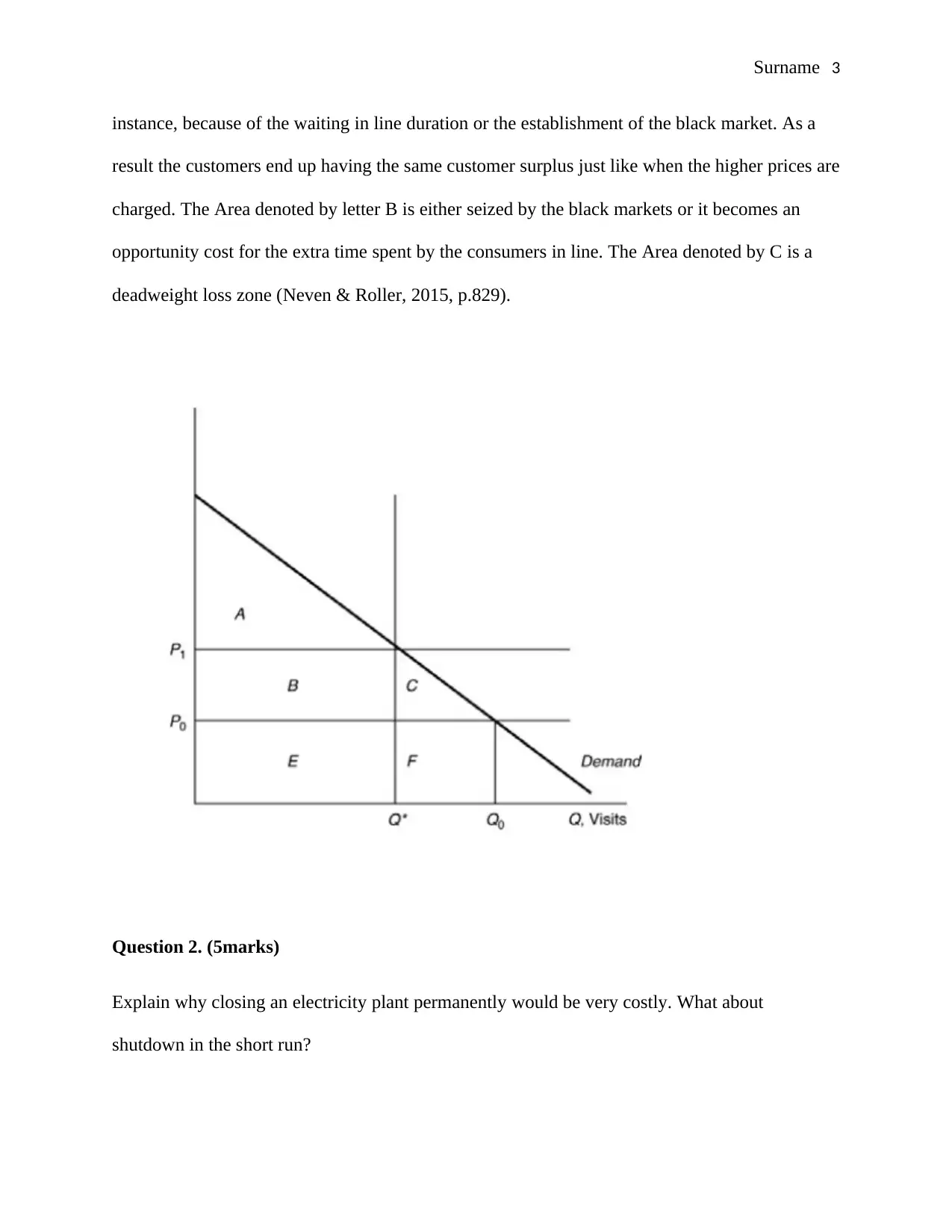
Surname 3
instance, because of the waiting in line duration or the establishment of the black market. As a
result the customers end up having the same customer surplus just like when the higher prices are
charged. The Area denoted by letter B is either seized by the black markets or it becomes an
opportunity cost for the extra time spent by the consumers in line. The Area denoted by C is a
deadweight loss zone (Neven & Roller, 2015, p.829).
Question 2. (5marks)
Explain why closing an electricity plant permanently would be very costly. What about
shutdown in the short run?
instance, because of the waiting in line duration or the establishment of the black market. As a
result the customers end up having the same customer surplus just like when the higher prices are
charged. The Area denoted by letter B is either seized by the black markets or it becomes an
opportunity cost for the extra time spent by the consumers in line. The Area denoted by C is a
deadweight loss zone (Neven & Roller, 2015, p.829).
Question 2. (5marks)
Explain why closing an electricity plant permanently would be very costly. What about
shutdown in the short run?
⊘ This is a preview!⊘
Do you want full access?
Subscribe today to unlock all pages.

Trusted by 1+ million students worldwide
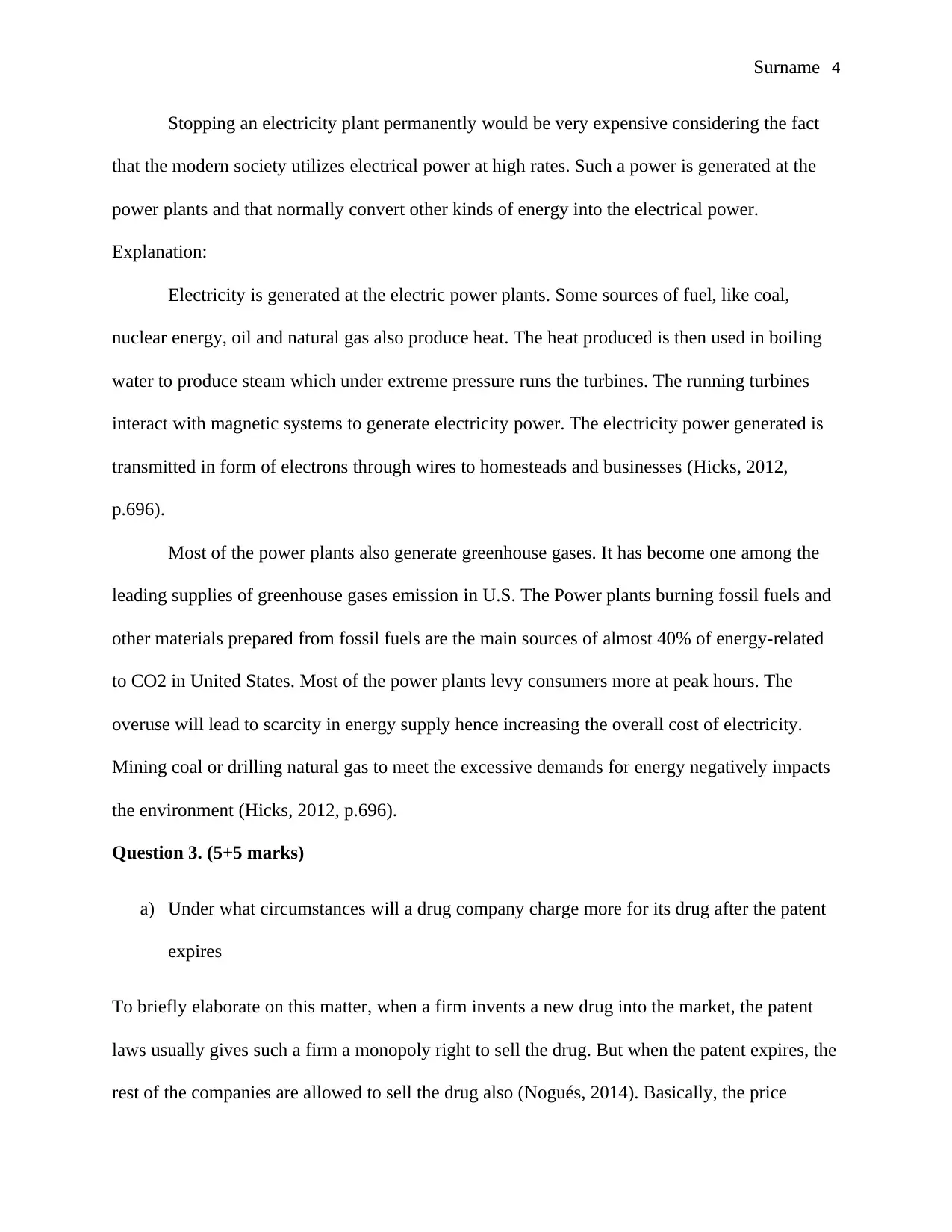
Surname 4
Stopping an electricity plant permanently would be very expensive considering the fact
that the modern society utilizes electrical power at high rates. Such a power is generated at the
power plants and that normally convert other kinds of energy into the electrical power.
Explanation:
Electricity is generated at the electric power plants. Some sources of fuel, like coal,
nuclear energy, oil and natural gas also produce heat. The heat produced is then used in boiling
water to produce steam which under extreme pressure runs the turbines. The running turbines
interact with magnetic systems to generate electricity power. The electricity power generated is
transmitted in form of electrons through wires to homesteads and businesses (Hicks, 2012,
p.696).
Most of the power plants also generate greenhouse gases. It has become one among the
leading supplies of greenhouse gases emission in U.S. The Power plants burning fossil fuels and
other materials prepared from fossil fuels are the main sources of almost 40% of energy-related
to CO2 in United States. Most of the power plants levy consumers more at peak hours. The
overuse will lead to scarcity in energy supply hence increasing the overall cost of electricity.
Mining coal or drilling natural gas to meet the excessive demands for energy negatively impacts
the environment (Hicks, 2012, p.696).
Question 3. (5+5 marks)
a) Under what circumstances will a drug company charge more for its drug after the patent
expires
To briefly elaborate on this matter, when a firm invents a new drug into the market, the patent
laws usually gives such a firm a monopoly right to sell the drug. But when the patent expires, the
rest of the companies are allowed to sell the drug also (Nogués, 2014). Basically, the price
Stopping an electricity plant permanently would be very expensive considering the fact
that the modern society utilizes electrical power at high rates. Such a power is generated at the
power plants and that normally convert other kinds of energy into the electrical power.
Explanation:
Electricity is generated at the electric power plants. Some sources of fuel, like coal,
nuclear energy, oil and natural gas also produce heat. The heat produced is then used in boiling
water to produce steam which under extreme pressure runs the turbines. The running turbines
interact with magnetic systems to generate electricity power. The electricity power generated is
transmitted in form of electrons through wires to homesteads and businesses (Hicks, 2012,
p.696).
Most of the power plants also generate greenhouse gases. It has become one among the
leading supplies of greenhouse gases emission in U.S. The Power plants burning fossil fuels and
other materials prepared from fossil fuels are the main sources of almost 40% of energy-related
to CO2 in United States. Most of the power plants levy consumers more at peak hours. The
overuse will lead to scarcity in energy supply hence increasing the overall cost of electricity.
Mining coal or drilling natural gas to meet the excessive demands for energy negatively impacts
the environment (Hicks, 2012, p.696).
Question 3. (5+5 marks)
a) Under what circumstances will a drug company charge more for its drug after the patent
expires
To briefly elaborate on this matter, when a firm invents a new drug into the market, the patent
laws usually gives such a firm a monopoly right to sell the drug. But when the patent expires, the
rest of the companies are allowed to sell the drug also (Nogués, 2014). Basically, the price
Paraphrase This Document
Need a fresh take? Get an instant paraphrase of this document with our AI Paraphraser
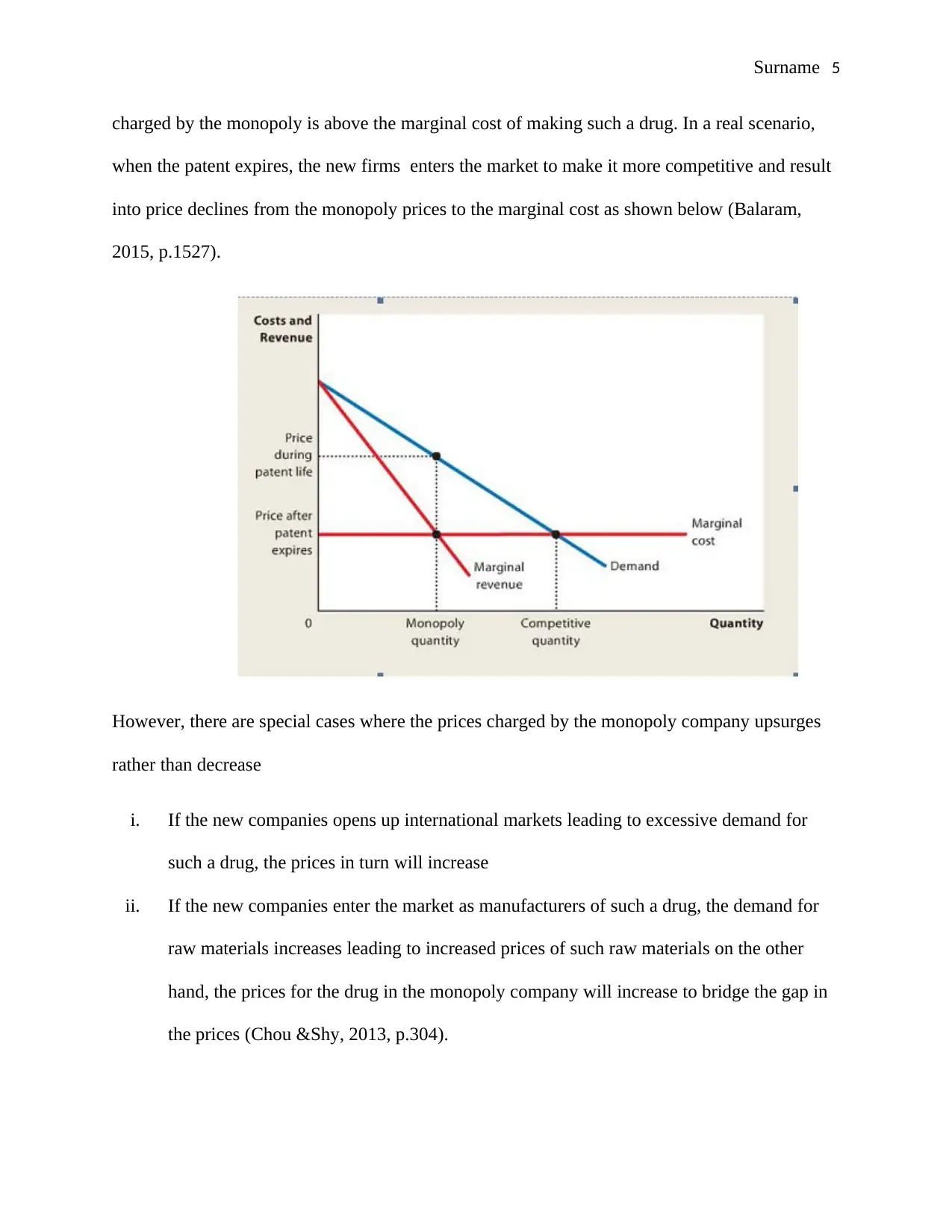
Surname 5
charged by the monopoly is above the marginal cost of making such a drug. In a real scenario,
when the patent expires, the new firms enters the market to make it more competitive and result
into price declines from the monopoly prices to the marginal cost as shown below (Balaram,
2015, p.1527).
However, there are special cases where the prices charged by the monopoly company upsurges
rather than decrease
i. If the new companies opens up international markets leading to excessive demand for
such a drug, the prices in turn will increase
ii. If the new companies enter the market as manufacturers of such a drug, the demand for
raw materials increases leading to increased prices of such raw materials on the other
hand, the prices for the drug in the monopoly company will increase to bridge the gap in
the prices (Chou &Shy, 2013, p.304).
charged by the monopoly is above the marginal cost of making such a drug. In a real scenario,
when the patent expires, the new firms enters the market to make it more competitive and result
into price declines from the monopoly prices to the marginal cost as shown below (Balaram,
2015, p.1527).
However, there are special cases where the prices charged by the monopoly company upsurges
rather than decrease
i. If the new companies opens up international markets leading to excessive demand for
such a drug, the prices in turn will increase
ii. If the new companies enter the market as manufacturers of such a drug, the demand for
raw materials increases leading to increased prices of such raw materials on the other
hand, the prices for the drug in the monopoly company will increase to bridge the gap in
the prices (Chou &Shy, 2013, p.304).
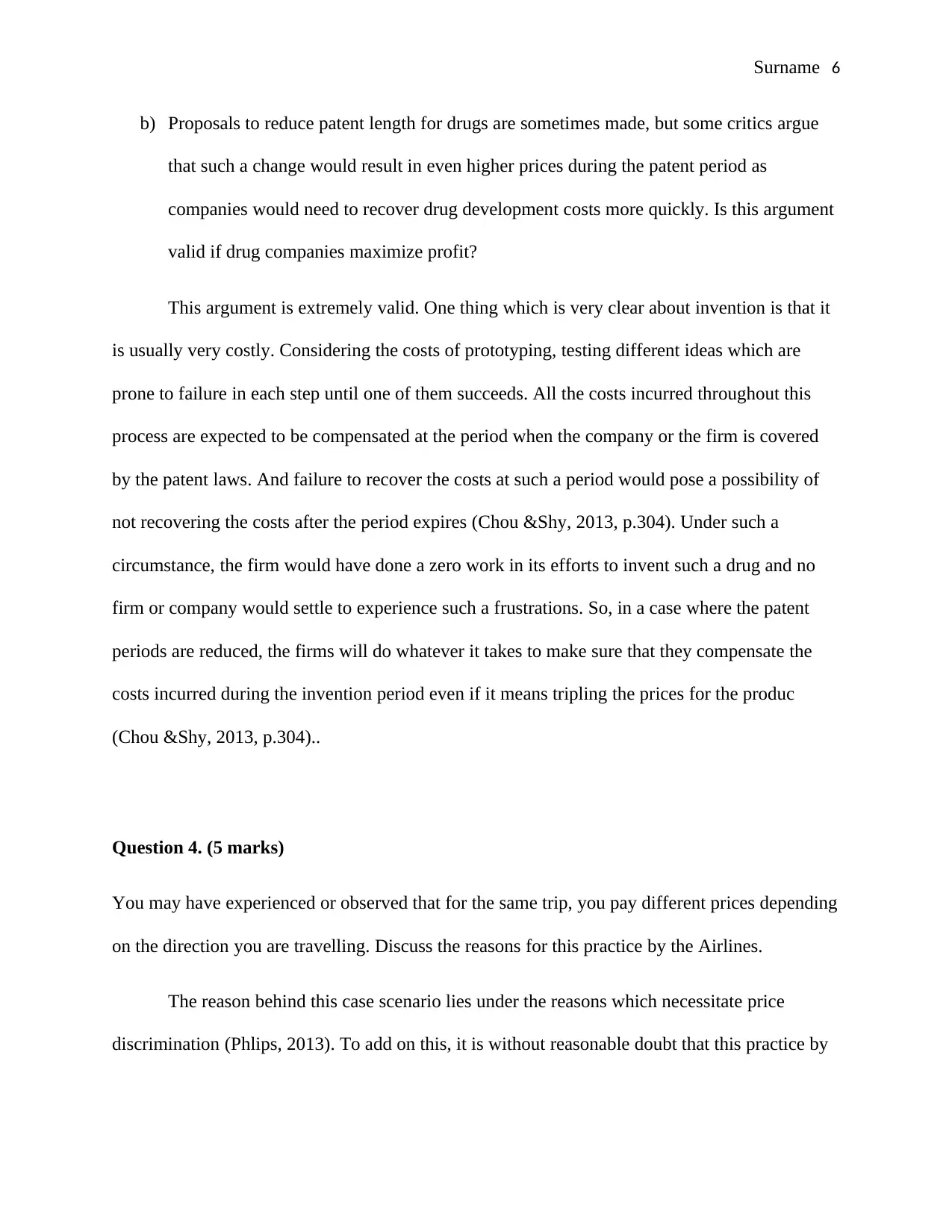
Surname 6
b) Proposals to reduce patent length for drugs are sometimes made, but some critics argue
that such a change would result in even higher prices during the patent period as
companies would need to recover drug development costs more quickly. Is this argument
valid if drug companies maximize profit?
This argument is extremely valid. One thing which is very clear about invention is that it
is usually very costly. Considering the costs of prototyping, testing different ideas which are
prone to failure in each step until one of them succeeds. All the costs incurred throughout this
process are expected to be compensated at the period when the company or the firm is covered
by the patent laws. And failure to recover the costs at such a period would pose a possibility of
not recovering the costs after the period expires (Chou &Shy, 2013, p.304). Under such a
circumstance, the firm would have done a zero work in its efforts to invent such a drug and no
firm or company would settle to experience such a frustrations. So, in a case where the patent
periods are reduced, the firms will do whatever it takes to make sure that they compensate the
costs incurred during the invention period even if it means tripling the prices for the produc
(Chou &Shy, 2013, p.304)..
Question 4. (5 marks)
You may have experienced or observed that for the same trip, you pay different prices depending
on the direction you are travelling. Discuss the reasons for this practice by the Airlines.
The reason behind this case scenario lies under the reasons which necessitate price
discrimination (Phlips, 2013). To add on this, it is without reasonable doubt that this practice by
b) Proposals to reduce patent length for drugs are sometimes made, but some critics argue
that such a change would result in even higher prices during the patent period as
companies would need to recover drug development costs more quickly. Is this argument
valid if drug companies maximize profit?
This argument is extremely valid. One thing which is very clear about invention is that it
is usually very costly. Considering the costs of prototyping, testing different ideas which are
prone to failure in each step until one of them succeeds. All the costs incurred throughout this
process are expected to be compensated at the period when the company or the firm is covered
by the patent laws. And failure to recover the costs at such a period would pose a possibility of
not recovering the costs after the period expires (Chou &Shy, 2013, p.304). Under such a
circumstance, the firm would have done a zero work in its efforts to invent such a drug and no
firm or company would settle to experience such a frustrations. So, in a case where the patent
periods are reduced, the firms will do whatever it takes to make sure that they compensate the
costs incurred during the invention period even if it means tripling the prices for the produc
(Chou &Shy, 2013, p.304)..
Question 4. (5 marks)
You may have experienced or observed that for the same trip, you pay different prices depending
on the direction you are travelling. Discuss the reasons for this practice by the Airlines.
The reason behind this case scenario lies under the reasons which necessitate price
discrimination (Phlips, 2013). To add on this, it is without reasonable doubt that this practice by
⊘ This is a preview!⊘
Do you want full access?
Subscribe today to unlock all pages.

Trusted by 1+ million students worldwide
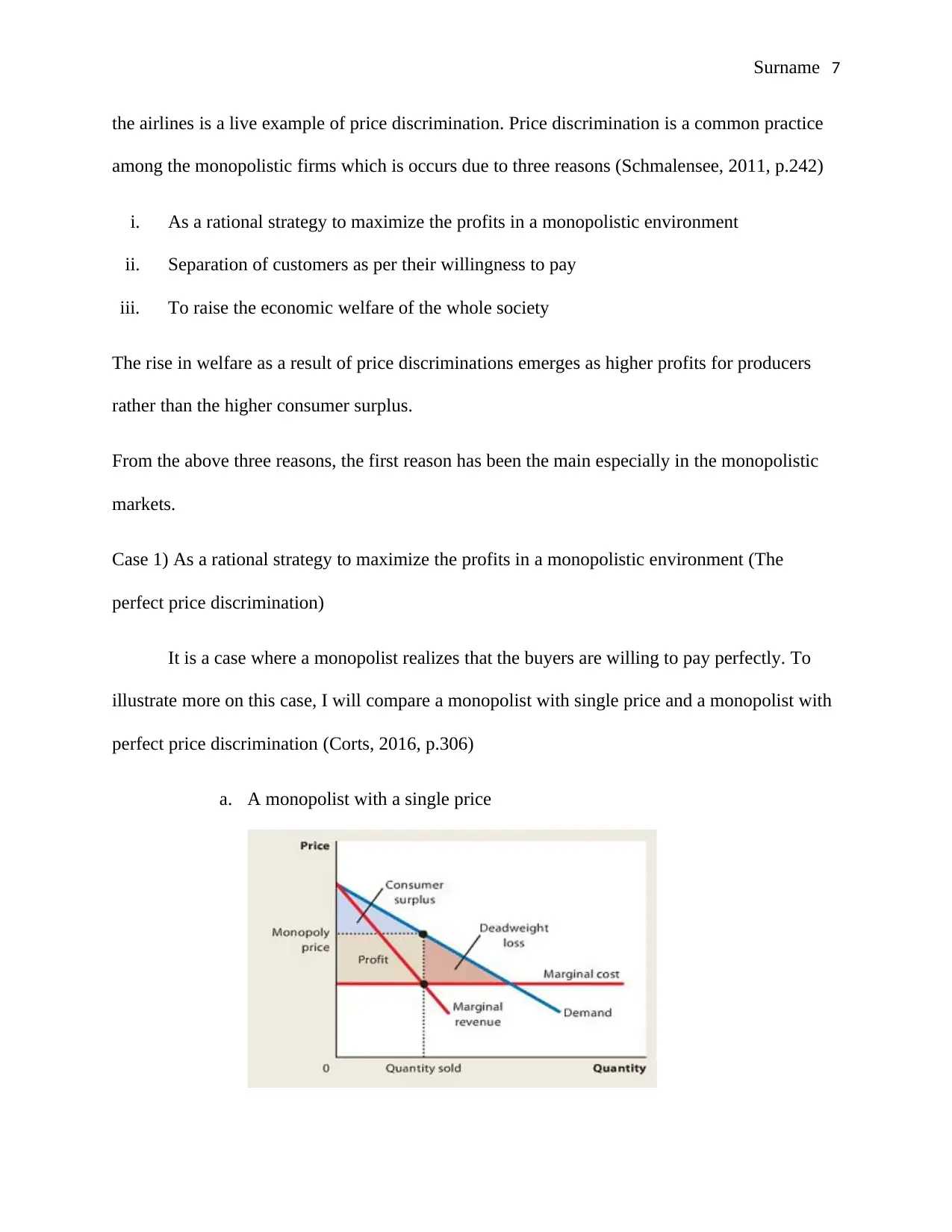
Surname 7
the airlines is a live example of price discrimination. Price discrimination is a common practice
among the monopolistic firms which is occurs due to three reasons (Schmalensee, 2011, p.242)
i. As a rational strategy to maximize the profits in a monopolistic environment
ii. Separation of customers as per their willingness to pay
iii. To raise the economic welfare of the whole society
The rise in welfare as a result of price discriminations emerges as higher profits for producers
rather than the higher consumer surplus.
From the above three reasons, the first reason has been the main especially in the monopolistic
markets.
Case 1) As a rational strategy to maximize the profits in a monopolistic environment (The
perfect price discrimination)
It is a case where a monopolist realizes that the buyers are willing to pay perfectly. To
illustrate more on this case, I will compare a monopolist with single price and a monopolist with
perfect price discrimination (Corts, 2016, p.306)
a. A monopolist with a single price
the airlines is a live example of price discrimination. Price discrimination is a common practice
among the monopolistic firms which is occurs due to three reasons (Schmalensee, 2011, p.242)
i. As a rational strategy to maximize the profits in a monopolistic environment
ii. Separation of customers as per their willingness to pay
iii. To raise the economic welfare of the whole society
The rise in welfare as a result of price discriminations emerges as higher profits for producers
rather than the higher consumer surplus.
From the above three reasons, the first reason has been the main especially in the monopolistic
markets.
Case 1) As a rational strategy to maximize the profits in a monopolistic environment (The
perfect price discrimination)
It is a case where a monopolist realizes that the buyers are willing to pay perfectly. To
illustrate more on this case, I will compare a monopolist with single price and a monopolist with
perfect price discrimination (Corts, 2016, p.306)
a. A monopolist with a single price
Paraphrase This Document
Need a fresh take? Get an instant paraphrase of this document with our AI Paraphraser
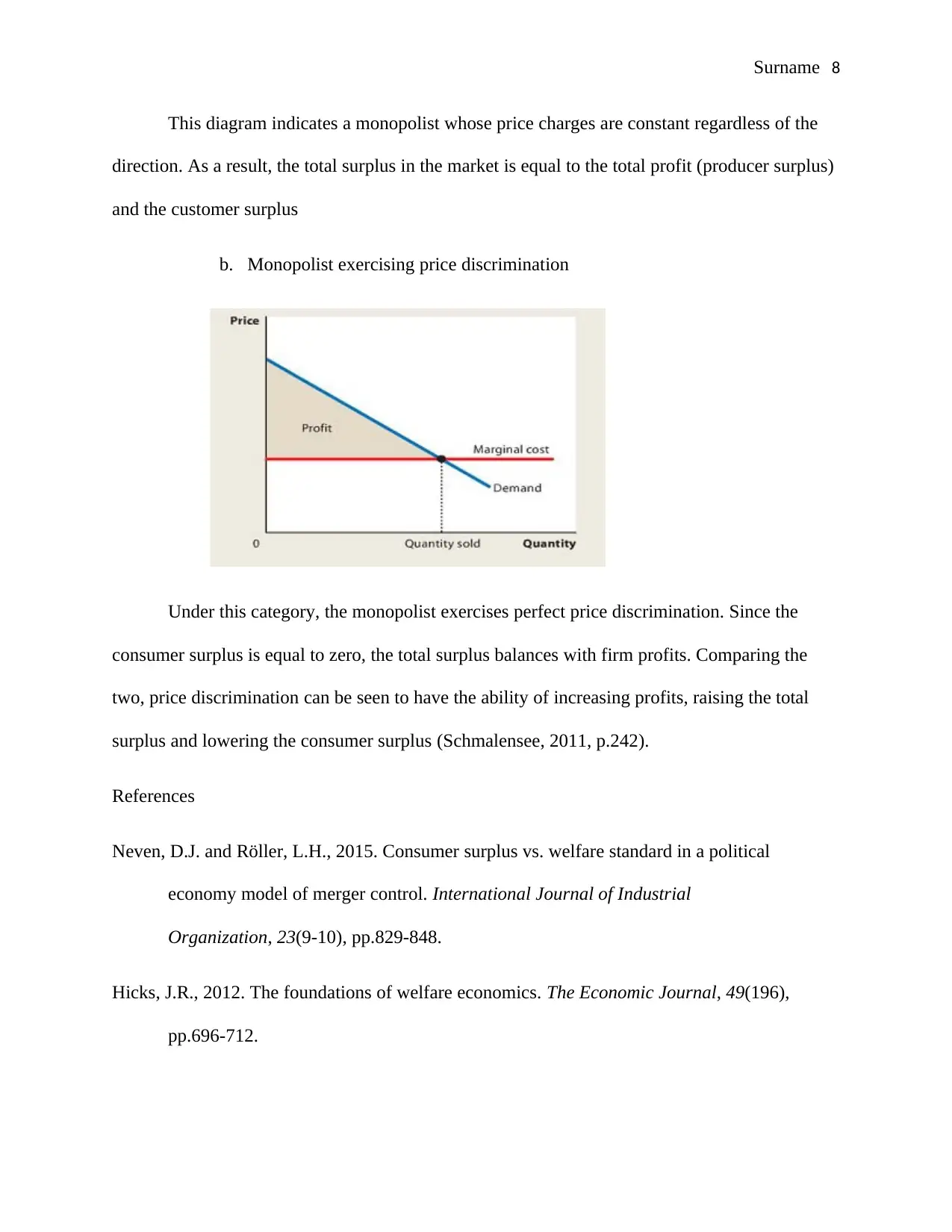
Surname 8
This diagram indicates a monopolist whose price charges are constant regardless of the
direction. As a result, the total surplus in the market is equal to the total profit (producer surplus)
and the customer surplus
b. Monopolist exercising price discrimination
Under this category, the monopolist exercises perfect price discrimination. Since the
consumer surplus is equal to zero, the total surplus balances with firm profits. Comparing the
two, price discrimination can be seen to have the ability of increasing profits, raising the total
surplus and lowering the consumer surplus (Schmalensee, 2011, p.242).
References
Neven, D.J. and Röller, L.H., 2015. Consumer surplus vs. welfare standard in a political
economy model of merger control. International Journal of Industrial
Organization, 23(9-10), pp.829-848.
Hicks, J.R., 2012. The foundations of welfare economics. The Economic Journal, 49(196),
pp.696-712.
This diagram indicates a monopolist whose price charges are constant regardless of the
direction. As a result, the total surplus in the market is equal to the total profit (producer surplus)
and the customer surplus
b. Monopolist exercising price discrimination
Under this category, the monopolist exercises perfect price discrimination. Since the
consumer surplus is equal to zero, the total surplus balances with firm profits. Comparing the
two, price discrimination can be seen to have the ability of increasing profits, raising the total
surplus and lowering the consumer surplus (Schmalensee, 2011, p.242).
References
Neven, D.J. and Röller, L.H., 2015. Consumer surplus vs. welfare standard in a political
economy model of merger control. International Journal of Industrial
Organization, 23(9-10), pp.829-848.
Hicks, J.R., 2012. The foundations of welfare economics. The Economic Journal, 49(196),
pp.696-712.
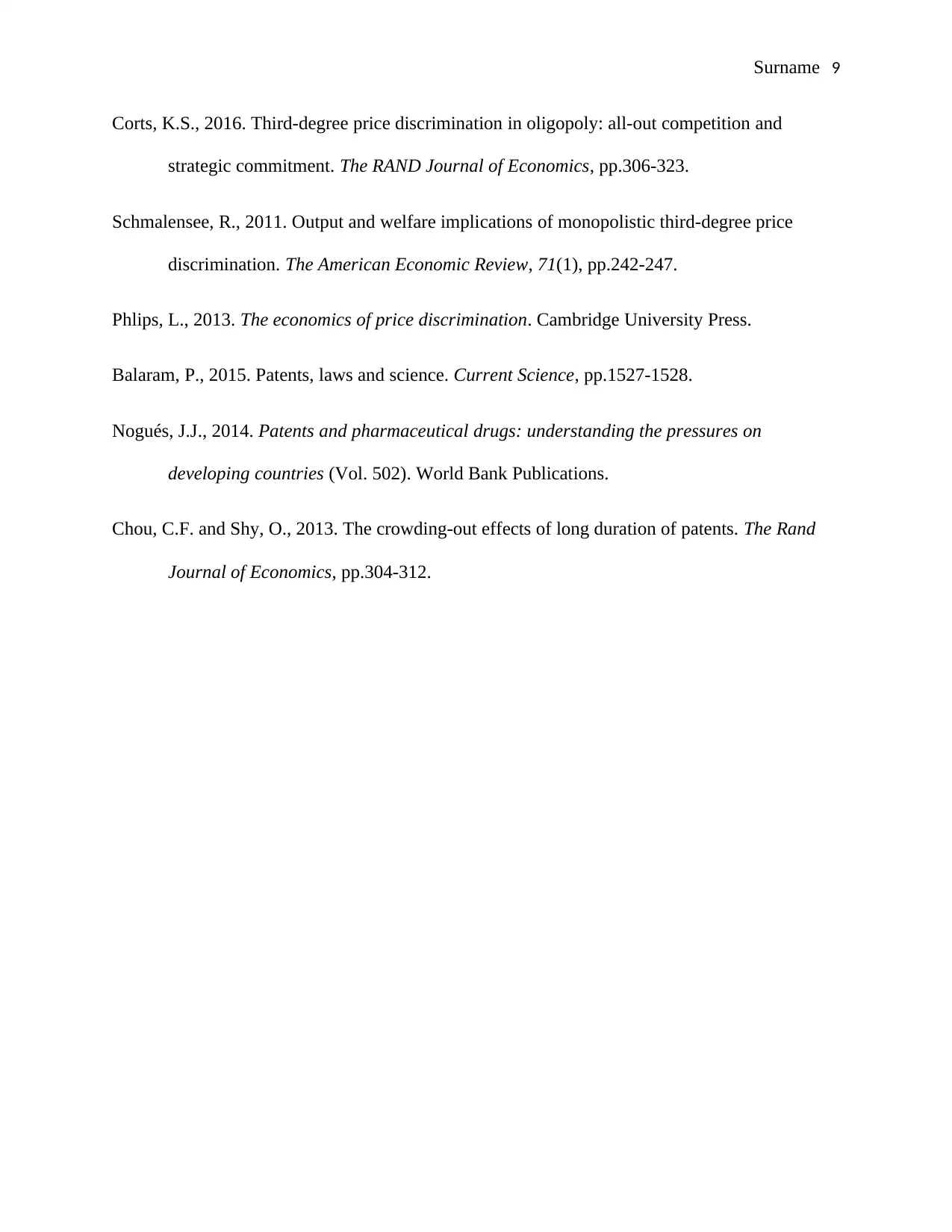
Surname 9
Corts, K.S., 2016. Third-degree price discrimination in oligopoly: all-out competition and
strategic commitment. The RAND Journal of Economics, pp.306-323.
Schmalensee, R., 2011. Output and welfare implications of monopolistic third-degree price
discrimination. The American Economic Review, 71(1), pp.242-247.
Phlips, L., 2013. The economics of price discrimination. Cambridge University Press.
Balaram, P., 2015. Patents, laws and science. Current Science, pp.1527-1528.
Nogués, J.J., 2014. Patents and pharmaceutical drugs: understanding the pressures on
developing countries (Vol. 502). World Bank Publications.
Chou, C.F. and Shy, O., 2013. The crowding-out effects of long duration of patents. The Rand
Journal of Economics, pp.304-312.
Corts, K.S., 2016. Third-degree price discrimination in oligopoly: all-out competition and
strategic commitment. The RAND Journal of Economics, pp.306-323.
Schmalensee, R., 2011. Output and welfare implications of monopolistic third-degree price
discrimination. The American Economic Review, 71(1), pp.242-247.
Phlips, L., 2013. The economics of price discrimination. Cambridge University Press.
Balaram, P., 2015. Patents, laws and science. Current Science, pp.1527-1528.
Nogués, J.J., 2014. Patents and pharmaceutical drugs: understanding the pressures on
developing countries (Vol. 502). World Bank Publications.
Chou, C.F. and Shy, O., 2013. The crowding-out effects of long duration of patents. The Rand
Journal of Economics, pp.304-312.
⊘ This is a preview!⊘
Do you want full access?
Subscribe today to unlock all pages.

Trusted by 1+ million students worldwide
1 out of 9
Your All-in-One AI-Powered Toolkit for Academic Success.
+13062052269
info@desklib.com
Available 24*7 on WhatsApp / Email
![[object Object]](/_next/static/media/star-bottom.7253800d.svg)
Unlock your academic potential
Copyright © 2020–2025 A2Z Services. All Rights Reserved. Developed and managed by ZUCOL.